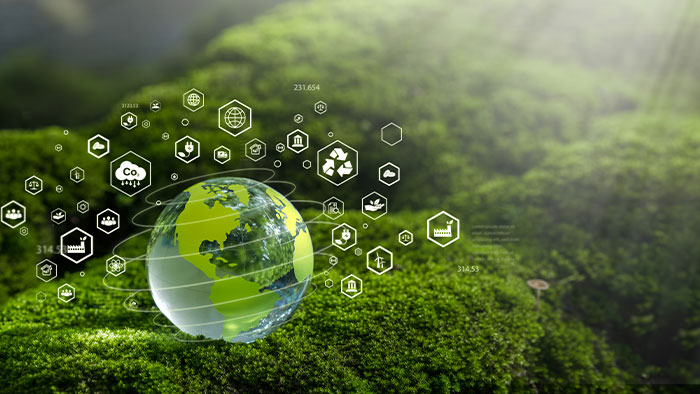Top 5 Environmental Sustainability Issues in Retail
- By [ Tiffin Shewmake ]
- 03/06/2017

# 1 Natural Resources in the Supply Chain
Products are the essence of retail so it's no surprise that natural resources top the retail sustainability list. The two main aspects that affect retail are the environmental impact of using raw materials and the risk of supply chain disruption. All natural resource use has some negative environmental impact and increasingly, a public that cares about minimizing it. Palm oil is one example as concerns over deforestation have pushed retailers to find more sustainable sources. A measure of these concerns is the proliferation of product certifications around sustainable attributes.
The other side of this issue is the potential of supply chain disruption from natural resource constraints. The impact of climate change on agriculture is a potential threat, for example, decreases in cocoa and coffee production are predicted. Other concerns include unsustainable harvesting, such as the many fish stocks that are at or over sustainable harvest limits and increasing water scarcity.
Understanding and responding to these issues is critical to meeting the challenge of operating more sustainably, reducing business risks and meeting consumer demands. The CRC page on Materiality and Risk Identification has more information on how to identify your risks and opportunities.
# 2 Environmental Impacts of Products
There are environmental impacts all along a product's life – natural resource extraction, water and energy used in production, pollution, transportation, use of the product and finally disposal. Some issues are unexpected, like aquatic pollution from microbeads that resulted in a microbead ban. Others are expected but can be controlled or, in some cases, eliminated, for example biodegradable packaging to eliminate plastic in the environment. There are also regulatory requirements designed to reduce negative impacts from product use such as emissions criteria for engines or sales restrictions, for example, on VOC levels in products.
Environmental aspects can also be positive, such as more energy or water efficient products. Increasingly, especially in construction, the Life Cycle Assessment of a product, an analysis that captures the environmental footprint and allows comparison of products, is important.
The way retailers address the environmental impact of products has a potential for positive results or major headaches. The CRC Sustainability Leadership Model helps retailers design programs to improve environmental performance and the Tools Page features a matrix of VOC limits by state.
# 3 Energy and Greenhouse Gases
Energy has huge environmental impacts, especially emissions of greenhouse gases and hazardous air pollutants from fossil fuel use. Energy efficiency and renewable energy can significantly reduce these impacts and also help retailers save money. An example is how more efficient lighting reduces emissions and saves money on energy while also reducing maintenance costs and waste. The retail industry is a leader in renewables; major retailers top the list of solar megawatts installed. Renewables are cleaner, cost competitive with conventional energy, provides companies with fixed energy costs and appeal to consumers looking for greener companies.
Transportation is another area where reducing energy use can save money. More efficient or alternative fuel vehicles, better management systems, planning and other approaches can reduce cost and environmental impacts. Visit the CRC Sustainability in Retail Logistics & Transportation page for more information.
Refrigerants can be potent greenhouse gases and also deplete the earth's protective ozone layer. To reduce this impact, the Clean Air Act covers refrigeration and air conditioning equipment. The CRC Refrigerant Fact Sheet has more information on these regulations.
The Retail Energy Leadership Model provide retailers with a roadmap to optimizing their energy programs and the Retail Operations page has information on financing energy projects.
# 4 Chemicals and Toxics
Many products contain chemicals. While most are not harmful, some have the potential to harm people or the environment. Many retailers are working to take these chemicals out of their products and supply chain. This can be a challenge; retailers have to work with manufacturers to find alternatives that are safer but don't affect cost and performance. Consumers want these safer products and retailers that can deliver have an advantage. Like natural resource sustainability, there are product certifications for safer products such as the Environmental Protection Agency's Safer Choice or the EWG Verified labels. The CRC Chemicals and Toxics in Retail and its Supply Chain page has more information.
There are also regulations, some at the state level, that ban or require labeling for specific substances. California's Prop65 has labeling requirements for over 800 substances and some states have bans that apply to specific uses such as in children's toys. The CRC Product Compliance and Toxics page has more information on regulations.
# 5 Waste
Waste is a problem on many levels because by definition it's, well, waste. Wasted money for products that can't be sold and for disposal costs, wasted resources when material is thrown away, and wasted benefits when items are not recycled. Waste has significant environmental impacts – landfills generate methane, which is a potent greenhouse gas, plus the environmental impacts from creating a material that is now thrown way. However, waste management is an exciting area as more facilities move towards the zero waste concept, and develop innovative approaches to reducing and reusing waste.
Many communities are implementing regulations to reduce waste and encourage recycling. This can include bans on non-reusable bags (the CRC Consumer Bag matrix has state and local regulations); landfill bans on specific items, including food waste; regulations on electronic waste (the CRC e-Waste matrix has state details); and increasingly, extended producer responsibility (EPR) requirements, many of which apply to retailers.
The application of hazardous waste regulations to unsalable consumer products has created a regulatory challenge for retailers. More sustainable approaches--reducing the amount of waste, products that might be considered hazardous, and promoting recycling—can reduce regulatory risk and costs. The CRC Hazardous Waste Page has more on this topic, the CRC Insights page has articles on hazardous waste in retail.
Operating more sustainably is a win-win opportunity for retail, customers and the environment. The Retail Sustainability Leadership Model provide the tools and resources to help retailers develop a sustainability framework improve environmental performance and take advantage of the tremendous opportunities a more strategic approach can provide.


